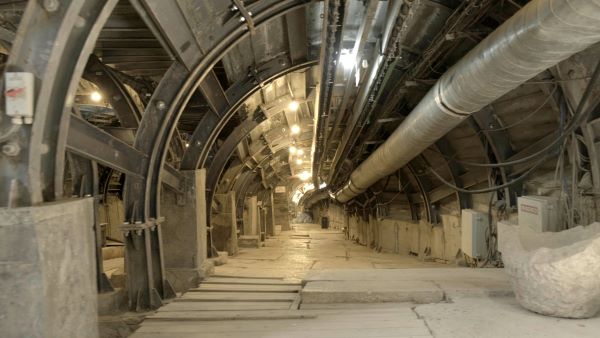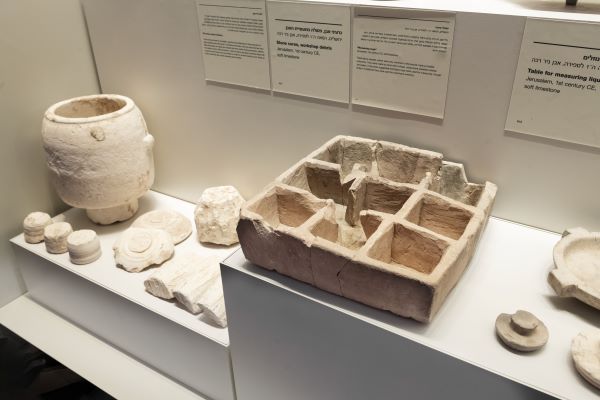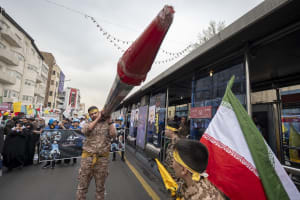Enigmatic rare stone box from the Second Temple period discovered in the City of David

A rare multi-compartment stone container dated to the 1st century A.D. was recently found at the City of David in Jerusalem during excavations of the Israel Authority Antiquities (IAA).
This unusual item was probably used for commercial activity and was found burnt, which is proof of the destruction of the city and the Temple about 2,000 years ago by the Roman army, later led by Emperor Titus.
Today, the box is revealed to the public for the first time in an exhibition at the Israel Museum in Jerusalem.
The box is carved in a square shape from soft limestone, measures 30 x 30 cm (11.81 x 11.81 inches), and has nine equal-sized compartments. On the sides of the box are some burn marks, indicating that it was in contact with a large fire, possibly during the great destruction of Jerusalem in 70 A.D.
Indeed, this box was discovered in a destruction layer dated to the end of the Second Temple period and around the years 60 to 70 A.D. It was located in an ancient shop room that once stood alongside the famous Pilgrimage Road in the City of David.

Dr. Yuval Baruch and Ari Levy, who are directing the excavation on behalf of the IAA stated: "During the excavations of the Pilgrimage Road, where the box was discovered, many objects have been found testament to the flourishing commercial activity that took place alongside the road during the Second Temple period. During the excavations, we uncovered ceramic and glass vessels, production and cooking facilities, various measuring tools, stone weights, and coins."
"Together, these objects suggest that the road was connected to commercial activities such as a lively urban market. The Pilgrimage Road connecting the Pool of Siloam to the Temple Mount was the main thoroughfare of the city 2,000 years ago. It seems that the newly discovered box was related to this commercial activity that took place along the Pilgrimage Road."
This discovery led scholars to interpret the uncommon box to be an item used for commerce, such as for displaying small-shaped goods, special food or tiny items for sale, perhaps souvenirs. In Judea during this period, the market and commercial system was similar to the ones known throughout the Roman Empire and included local, imported and fancy or exotic goods.
Around 50 years ago, archaeologist Nachman Avigad stumbled upon fragments of a comparable box during excavations in the Jewish Quarter of the Old City of Jerusalem. Upon its unearthing, Avigad whimsically dubbed the artifact a "nuts and seeds bowl," a moniker that has endured.
The recently-discovered box stands out as the sole complete specimen. Intriguingly, all analogous box fragments have been unearthed in Jerusalem, predominantly within the City of David.
Life during the Second Temple period was conducted with strict respect for the rabbinical and Mosaic laws regarding purity. During Jesus' ministry, this reality was lived in a daily manner; remember the Jews asking Jesus why his disciples were not washing their hands before meals (Matthew 15:2).
This can be seen in the archaeological finds of this period, which were often made of limestone and whose fragments can be found almost in every Jewish archaeological site after this period.
These fragments came from the huge basins called "Kalal" in Jewish ancient literature, and from cups, vessels, bowls, ossuaries, and now even from boxes, as there was a traditional Jewish belief that ritual impurity could not be transferred through stone vessels.
The stone vessel items were a part of a massive manufacturing and commercial trade that answered a large demand among Jews of Jesus' time. Many sites related to the carving and the manufacture of the vessels have been excavated and discovered in Israel: One recently at Nazareth, and multiple ones around Jerusalem and in other locations.
"It seems that the multi-compartment stone box from the City of David was related to the unique Jerusalem economy conducted in the shadow of the temple maintaining strict observance and in accordance with purity laws. Therefore, we can consider this box a distinctly Jerusalem find,” Levy and Dr. Baruch said.

The box was originally found in fragments, broken into pieces possibly caused by the 70 A.D. destruction. The fragments were brought to the Israel Museum before their exhibition. Victor Uziel, a conservationist of the museum conservation laboratory directed the scientific delicate repairing of the item.
Dudi Mevorah, the museum's senior curator in the archaeological department, noted that the stone box "has been placed on permanent display together with spectacular colorful frescos, chandeliers and magnificent pottery, stone and metal vessels from Jerusalem's luxury houses dating to the end of the Second Temple period."

The All Israel News Staff is a team of journalists in Israel.














